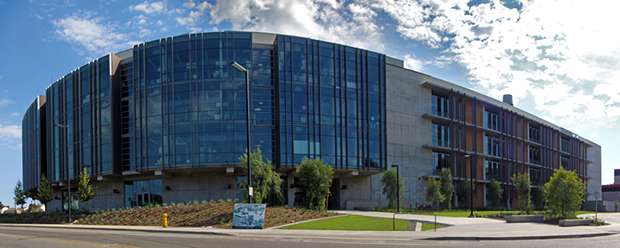The UCSD Structural and Materials Engineering Building stands as a testament to innovation and forward-thinking design, a place where future engineers and scientists push the boundaries of what’s possible. It is more than just a building; it’s a living laboratory, fostering collaboration and groundbreaking research in fields crucial to our modern world. The building’s design cleverly integrates functionality with aesthetics, creating a space that is both inspiring and conducive to learning. The **UCSD Structural and Materials Engineering Building** truly embodies the spirit of exploration and discovery.
Innovative Design and Functionality
The architectural brilliance of the **UCSD Structural and Materials Engineering Building** is evident in its thoughtful layout and use of materials. The building is designed to maximize natural light and ventilation, creating a comfortable and sustainable environment for students and researchers. It features state-of-the-art laboratories, flexible classroom spaces, and collaborative workspaces that encourage interaction and knowledge sharing.
- Open-concept laboratory spaces
- Dedicated materials testing facilities
- Advanced computational modeling labs
- Sustainable design features
Research Areas and Focus
The building houses a wide range of research activities, focusing on critical areas such as:
- Structural Health Monitoring: Developing advanced sensors and algorithms to assess the integrity of bridges, buildings, and other infrastructure.
- Advanced Materials: Creating new materials with enhanced properties for applications in aerospace, energy, and biomedical engineering.
- Sustainable Engineering: Designing eco-friendly infrastructure and developing innovative solutions for environmental challenges.
Impact on Engineering Education
The UCSD Structural and Materials Engineering Building plays a vital role in shaping the next generation of engineers. By providing students with access to cutting-edge facilities and opportunities to participate in groundbreaking research, the building helps them develop the skills and knowledge necessary to address the challenges of the 21st century. The building fosters a culture of innovation and collaboration, encouraging students to think critically and creatively.
Consider, for example, the impact of access to advanced testing equipment. Students can directly apply theoretical knowledge learned in the classroom to real-world scenarios, solidifying their understanding and preparing them for future careers in engineering.
A Hub for Collaboration and Discovery
The UCSD Structural and Materials Engineering Building is more than just a place to conduct research; it’s a vibrant hub for collaboration and discovery. The building brings together faculty, students, and industry partners to work on cutting-edge projects that have the potential to transform our world. As the final paragraph commences, it is important to highlight that the **UCSD Structural and Materials Engineering Building** represents a significant investment in the future of engineering and a testament to the university’s commitment to innovation and excellence.
Imagine walking through its halls, not just as a student or researcher, but as an explorer in a landscape of potential. The hum of machinery isn’t just noise; it’s the symphony of creation. The blinking lights of computers aren’t just data processing; they’re the stars in a digital constellation, guiding the way to new discoveries. Each room is a portal, leading to a different dimension of engineering possibility. You might stumble upon a team crafting materials lighter than air yet stronger than steel, or witness simulations predicting the behavior of structures under the most extreme conditions. The air crackles with intellectual energy, a tangible force that propels innovation forward.
BEYOND THE BLUEPRINT: A LIVING ORGANISM
Forget the sterile image of a typical engineering building. This structure breathes. Its walls absorb and reflect the constant flow of ideas, its labs pulsate with the rhythm of experimentation. It’s a living organism, constantly evolving, adapting, and growing. Imagine algorithms that learn from the building’s own performance, adjusting ventilation and lighting to optimize energy efficiency and create a more comfortable environment. Imagine sensors woven into the very fabric of the structure, monitoring its health and predicting potential failures before they even occur. This isn’t just a building; it’s a sentient being, a partner in the pursuit of knowledge.
– Self-Healing Concrete: Microscopic capsules embedded within the concrete release a healing agent when cracks form, extending the lifespan of the structure.
– Kinetic Façade: The building’s exterior responds to sunlight and wind, adjusting its panels to regulate temperature and maximize natural light.
– Virtual Reality Design Studios: Immerse yourself in a virtual world to test structural designs and collaborate with engineers from around the globe.
THE ECHOES OF INNOVATION
Close your eyes and listen. Can you hear the echoes of past breakthroughs? The whispers of theorems proven, the triumphant shouts of engineers who overcame seemingly insurmountable challenges? This building carries the weight of history, not as a burden, but as a source of inspiration. Every corner holds a story, every lab a potential turning point. It’s a place where legends are made, where the impossible becomes reality. The students who walk these halls aren’t just learning about engineering; they’re becoming part of its ongoing narrative, adding their own voices to the chorus of innovation.
Furthermore, the open-door policy between different research groups encourages unexpected collaborations, leading to serendipitous discoveries that would never have been possible in a more siloed environment.
THE FUTURE FORGED HERE
The UCSD Structural and Materials Engineering Building isn’t just about the present; it’s about the future. It’s a crucible where the seeds of tomorrow’s technologies are being sown. As you leave this architectural marvel, remember that it represents not just concrete and steel, but the boundless potential of human ingenuity. The future of structural engineering is being written within its walls, one experiment, one simulation, one groundbreaking discovery at a time. And as the sun sets, casting long shadows across its façade, you can almost hear the building whispering, “What will you create?”







